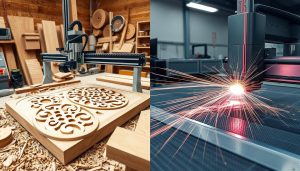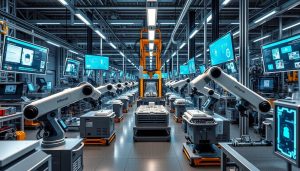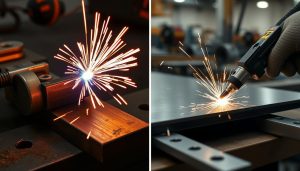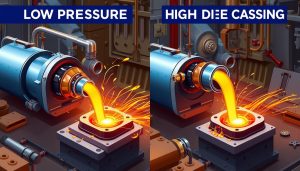In the world of automated manufacturing, G-code stands as the fundamental programming language that drives the precision and efficiency of Computer Numerical Control (CNC) machines and 3D printers. As a set of instructions that dictate the movements, tool usage, and operations performed by these advanced machines, G-code is the backbone of modern manufacturing processes across a wide range of industries.
G-code, also known as numerical control code, is the language that translates human-designed blueprints and prototypes into the precise, automated actions that bring products to life. By understanding the intricacies of this programming language, manufacturers can unlock the full potential of their CNC and 3D printing capabilities, enabling them to create complex, high-quality parts and components with unparalleled consistency and repeatability.
What is G-code?
G-code, also known as the “Geometric Code,” is the foundation of computer numerical control (CNC) programming and 3D printing technology. This standardized language emerged in the 1950s and has since become the primary means of controlling automated manufacturing equipment, from CNC machines to 3D printers.
Definition and Origin of G-code
G-code provides precise instructions for tool movement, speed, and other operational parameters, enabling the precise control of manufacturing processes. The language was initially developed to guide the mechanical movements of CNC machines, and its versatility has since expanded to encompass additive manufacturing techniques, such as 3D printing.
G-code in CNC and 3D Printing
In the realm of CNC machining, G-code directs the movement of cutting tools to shape and sculpt materials with extraordinary precision. Similarly, in 3D printing, G-code guides the deposition of successive layers of material, allowing for the creation of complex, three-dimensional objects. This universal language has become the lingua franca of automated manufacturing, unifying diverse technologies and enabling seamless integration between digital designs and physical production.
“G-code has revolutionized the way we manufacture products, bridging the gap between digital design and physical reality.”
Key Functions of G-code
G-code, the programming language at the heart of Computer Numerical Control (CNC) machining and 3D printing, serves as a crucial link between digital designs and physical manufacturing. This powerful set of commands and functions orchestrates the intricate movements and actions of CNC machines, enabling precise control over the entire production process.
Movement Control in CNC Machines
One of the primary responsibilities of G-code is to manage the movement of tools and workpieces within CNC machines. G-code commands dictate the linear, circular, and rapid positioning of these elements, ensuring that the desired part geometry is accurately produced. By specifying the precise coordinates and trajectories, G-code ensures that the CNC machine control is executed with the utmost precision.
G-code Commands and Their Roles
- Rapid Positioning (G0): Enables fast, non-cutting movements between specific locations.
- Linear Interpolation (G1): Controls steady, linear cutting motions along a specified tool path programming.
- Circular Interpolation (G2, G3): Manages the creation of arcs and circular features through coordinated rotational and linear movements.
- Spindle Control (M3, M4, M5): Regulates the speed and direction of the spindle for cutting, drilling, and other G-code functions.
- Tool Changes (T, M6): Coordinates the automatic exchange of tools within the CNC machine to facilitate complex, multi-step operations.
By leveraging this diverse set of G-code commands, CNC operators and programmers can precisely control the manufacturing process, ensuring optimal efficiency, quality, and repeatability.

Common G-code Commands and Their Applications
As the foundation of CNC programming and 3D printing, understanding the common G-code commands and their specific applications is crucial for creating efficient and accurate manufacturing processes. From linear movements to circular motions and specialized tool control, let’s dive into the key G-code commands that shape the world of computer-controlled fabrication.
G0 and G1 – Linear Movements
The most basic G-code commands, G0 and G1, are responsible for directing the tool or print head to move in a straight line. G0, also known as the “rapid move,” instructs the machine to move at its fastest possible speed, while G1 controls the linear motion at a specified feed rate. Mastering these linear movement commands is essential for optimizing cutting and printing paths, ensuring precision and reducing production time.
G2 and G3 – Circular Movements
For creating curved surfaces and arcs, G-code provides the G2 and G3 commands. G2 controls clockwise circular motion, while G3 governs counterclockwise circular movements. These commands allow CNC operators and 3D printing enthusiasts to generate complex shapes and geometries, expanding the design possibilities for their projects.
G-code for Tool Control
In addition to movement commands, G-code also includes a set of instructions for controlling the various tools used in CNC machining and 3D printing. From selecting the appropriate tool (G43, G44) to adjusting the tool’s offset (G43, G49) and activating the spindle (M3, M4, M5), these specialized commands ensure that the correct tools are used at the right time, maintaining the integrity of the manufacturing process.
Special Commands in 3D Printing
While many G-code commands are shared between CNC and 3D printing, the world of additive manufacturing also has its own unique set of instructions. Commands like G92 (set position) and G28 (home) are commonly used in 3D printing to establish the print bed’s origin and return the print head to its starting position, respectively. Understanding these special commands is essential for achieving successful 3D printing outcomes.
By mastering the common G-code commands and their applications, CNC operators, 3D printing enthusiasts, and manufacturing professionals can unlock the full potential of computer-controlled fabrication, optimizing their workflows and delivering high-quality, precision-driven products.

How G-code is Used in Manufacturing
G-code, the programming language that controls CNC machines and 3D printers, plays a vital role in modern manufacturing processes. Its ability to precisely control the movement and actions of these machines has made it an indispensable tool in the world of precision manufacturing.
Precision in CNC Machining
In CNC machining, G-code commands dictate the cutting, drilling, and shaping of materials with unparalleled accuracy. By specifying the exact coordinates, speeds, and feed rates, G-code enables CNC machines to produce complex parts and components with exceptional precision. This precision is crucial in industries such as aerospace, automotive, and medical device manufacturing, where even the slightest deviation can have significant consequences.
Applications in Additive Manufacturing
G-code also plays a crucial role in additive manufacturing, or 3D printing. In this process, G-code controls the deposition of materials, layer by layer, to create intricate and customized three-dimensional objects. From prototyping to small-batch production, additive manufacturing processes rely on the precision and flexibility offered by G-code to bring innovative designs to life.
Whether in CNC machining or additive manufacturing, G-code’s ability to ensure CNC precision and accuracy has made it an indispensable tool in the world of modern G-code in manufacturing.
Benefits of Using G-code in CNC and 3D Printing
The utilization of G-code, the programming language used in CNC machining and 3D printing, offers numerous advantages that enhance manufacturing processes. From increased efficiency and automation to high precision and accuracy, G-code empowers manufacturers to create complex designs with ease.
Increased Efficiency and Automation
G-code automates the manufacturing process, allowing CNC machines and 3D printers to operate with minimal human intervention. This automation not only boosts production speed but also reduces the potential for human error, leading to more reliable and consistent outcomes. By streamlining the manufacturing workflow, G-code significantly improves overall efficiency and productivity.
High Precision and Accuracy
One of the key benefits of G-code is its ability to ensure high precision and accuracy in CNC machining and 3D printing. The detailed instructions provided by G-code enable machines to execute movements with exceptional accuracy, producing parts and components that meet the most stringent design specifications. This level of precision is essential for industries that require tight tolerances, such as aerospace, medical, and automotive.
Flexibility for Complex Designs
G-code offers unparalleled flexibility, allowing manufacturers to create intricate and complex designs with ease. The language’s extensive commands and functions enable the control of various machine movements, tool changes, and other parameters, empowering designers and engineers to bring their most ambitious projects to life. This flexibility is particularly valuable in the realm of 3D printing precision, where G-code enables the creation of complex geometries and shapes that would be challenging to achieve through traditional manufacturing methods.
In summary, the benefits of using G-code in CNC machining and 3D printing are multifaceted, encompassing increased efficiency and automation, high precision and accuracy, and the flexibility to tackle complex designs. By leveraging the power of G-code, manufacturers can streamline their operations, enhance the quality of their products, and push the boundaries of what is possible in modern manufacturing.
How to Learn and Master G-code
Mastering G-code, the programming language behind Computer Numerical Control (CNC) machining and 3D printing, is a valuable skill for any aspiring machinist or engineer. Whether you’re a beginner looking to get started or an experienced programmer seeking to refine your techniques, there are ample resources available to help you on your journey.
Resources for Beginners
For those new to the world of CNC programming, there are a wealth of online tutorials, courses, and practice software that can help you develop a strong foundation in learning G-code. From interactive tutorials that walk you through the basics to hands-on simulations that allow you to experiment with different commands, these resources offer a comprehensive introduction to the world of CNC programming.
- Online tutorials and video lessons on learning G-code
- Introductory courses on CNC programming and G-code
- G-code simulation software for practicing and honing your skills
Best Practices for Advanced Programmers
For seasoned CNC programmers, mastering the art of G-code optimization is key to enhancing efficiency and precision. By adhering to best practices, you can streamline your code, reduce processing time, and create intricate designs with unparalleled accuracy.
- Familiarize yourself with common G-code commands and their applications
- Optimize your code for maximum speed and efficiency
- Troubleshoot and debug common issues in your G-code programming
- Stay up-to-date with the latest advancements in CNC technology and programming
Whether you’re just starting your journey or looking to refine your skills, the resources and best practices outlined here can help you become a true master of G-code programming. With dedication and a commitment to continuous learning, you can unlock the full potential of CNC machining and 3D printing to elevate your manufacturing capabilities.
Why Choose Shixinproto for Your G-code CNC Machining Needs
Shixinproto has established itself as a leader in the CNC machining industry, offering exceptional expertise in G-code programming and custom manufacturing solutions. With a team of experienced professionals, Shixinproto is the go-to partner for businesses seeking precision-engineered components and parts.
Shixinproto’s Expertise in CNC Programming and G-code
At the heart of Shixinproto’s success is their deep understanding of CNC programming and the G-code language. Their team of skilled technicians and engineers have mastered the intricacies of G-code, enabling them to create precise, efficient, and reliable CNC programs for a wide range of applications. Whether it’s complex 3D printing projects or intricate CNC machining tasks, Shixinproto’s expertise in G-code ensures that your manufacturing needs are met with the utmost precision.
Custom Solutions for Your Project
Shixinproto recognizes that every project is unique, which is why they offer customized solutions tailored to your specific requirements. Their team works closely with clients to understand their goals, design specifications, and manufacturing needs, and then leverages their expertise in CNC programming and G-code to deliver custom-made parts and components that exceed expectations. From prototyping to full-scale production, Shixinproto’s commitment to quality and innovation ensures that your project is a success.
Contact Shixinproto for Professional CNC Services
If you’re looking for a reliable and experienced partner for your G-code CNC machining needs, look no further than Shixinproto. Their team of experts is ready to work with you to create the high-quality, precision-engineered parts and components you need. Contact Shixinproto today to learn more about their CNC services and how they can help your business thrive.





